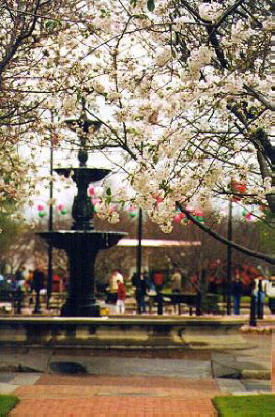|

Phone Numbers:
Robert Ham
229- 995-2579
Jake Akins
478-784-0304. |
|
When Hernando deSoto journeyed through this area in
1540 the city limits of present-day Macon had been inhabited for
thousands of years. Many cultures inhabited the "Fall Line" including
Moundbuilders and the Hitchiti, who would later move south and form the
core of the Seminole Tribe. When English traders visited a group of
Native Americans, probably in 1686 under the command of Dr. Henry
Woodward, they referred to them as the "Ochese (Ocmulgee) Creek,"
eventually dropping the "Ochese" and simply calling these people Creek
Indians. The traders opened a post a few years later (now protected as
part of the Ocmulgee National Monument) and from this point in time
forward the area had English settlers continuously.
These settlers were frequently threatened by both Creek and Cherokee
Indians, the French to the west and the Spanish to the south until
1702-1703 when repeated victories drove the Spanish army from Central
Georgia. From this point on only Spanish miners would occasionally pass
through, headed north to gold fields along the Chattahoochee River near
its confluence with Duke's Creek.
In 1739 James Oglethorpe and a group of Georgia Guard passed by the
Ocmulgee Old Fields, the ancient mounds considered holy by the Creek. A
member of the guard made a note about the mounds, marking the first
written account of the Ocmulgee Old Fields.
William Bartram, who explored coastal and inland Georgia, passed the
Ocmulgee River in the vicinity of Macon. Travelling east-west, his route
led him on to the Creek capital of Coweta.
The westward push of the settlers had forced repeated cessions from the
Creek Nation to England, Georgia, and finally the United States of
America. The Treaty of Fort Wilkerson (June 16, 1802) and the Treaty of
Washington (Nov 14, 1805) pushed the frontier of Georgia to the banks of
the Ocmulgee and beyond. The settlers moving in demanded protection and
Fort Hawkins was built. Named in honor of Benjamin Hawkins,
Superintendent of the Southern Indians, the fort would play a pivotal
role in the history of the state over the next 15 years, eventually
bypassed by forts further west and south. Fort Hawkins' suttlers row
grew into Newtown, near the ferry across the Ocmulgee River, which
transported travelers along the Creek Trading Path (later known as the
Federal Highway).
In 1822 Bibb County was created by the Georgia legislature. The
following year, across the Ocmulgee from Fort Hawkins, Macon was formed,
named in honor of Nathaniel Macon, an anti-Federalist North Carolinian
served as Speaker of the House, president pro-tem of the Senate and made
unsuccessful attempt at the vice-presidency in 1824. He was a powerful
friend of Thomas Jefferson who has been relegated to footnote role in
American history, beloved by Georgians for his strong states rights
views. The basic design of the city is generally credited to James Webb.
In 1825 the Marquis de Lafayette visited the town on the Ocmulgee as he
journeyed from coastal Georgia to Alabama on a trip that would take him
to each of the states in the nation. It was the start of a series of
major events that took place in Macon, Georgia over the next 35 years.
Newtown, including the site of Fort Hawkins, was annexed in 1829. On
December 23, 1836 the Georgia Female College was chartered by the state.
It would open its doors two years later on January 7, 1839 under the
direction of George Foster Pierce. The ninety women who were enrolled
represented the first female college class in the world. Today the
Georgia Female College is known as Wesleyan College.
Macon's antebullum architecture reflects the wealth of the city
(Pictured: Hay House)
Sidney Lanier, who name is best known for the northeast Georgia's Lake
Sidney Lanier, was born in Macon in 1845, the same year that the Central
Railroad completed a line from Savannah to Macon, linking central
Georgia's agricultural wealth to the coastal ports for shipping. In 1852
the kazoo was introduced at the Georgia State Fair. Created by Alabama
Vest in Macon in the 1840's, it was manufactured by German clockmaker
Thaddeus Von Clegg. In 1855 a referendum held to determine a capital
city for Georgia, Macon came in last with 3,802 votes.
During the Civil War the city served as a hospital for wounded
Confederates, a prison for Union soldiers, who were housed at the old
fairgrounds and a manufacturing center for Confederate weapons. The
Findley Iron Works built 80 1,500 lbs. cannon between 1862 and 1864.
Macon was attacked in 1864 by General George Stoneman's cavalry in an
ill-fated foray known as "The Stoneman Raid." The attack was repulsed by
troops under the command of Howell Cobb. As General William Sherman
approached the city towards the end of August, 1864, the interment camp
was broken up and the prisoners spread out to other area camps.
(continued in next column) |
 |
|
In November, 1864, Sherman was well on his
"March to the Sea" (which surprisingly bypassed Macon and the
Macon Arsenal) when Governor Joseph E. Brown decided to move the capital
to Macon, to keep the state's records safe. A legislature was seated in
the old city hall from February 15 until March 11, 1865. The city was
finally captured, and under the command of General James H. Wilson at
the end of the Civil War
Milledgeville retook its title of capital in December, 1865. Through
Reconstruction and into the 20th century, Macon grew into its
predominent role in central Georgia as a town built on an agricultural
base, creating a transportation hub. Building this hub after the Civil
War destroyed significant portions of the Ocmulgee Old Fields on two
occasions.
In 1909 photographer Lewis Wickes Hine visited the mills in Macon as
part of a project to photograph child labor abuses (he failed to tell
this to the owners of the mills). He visited Payne Mills and the Bibb
Manufacturing Company, both in Macon. The photographs he shot there
vividly depict the plight of young children who were working in these
plants.
One requirement for the expanding city was power. Lake Jackson was
completed in 1910 to meet this need. Construction on Camp Wheeler, named
for Confederate Cavarly General Joseph Wheeler, began in July, 1917. It
played an important role in training men from across the South to fight
in World War I. These young men were frequently entertained by artists
and musicians thanks to the work of the local Womans Club and the
Y.W.C.A. Camp Wheeler was dismantled 18 months later.
After World War I Macon hit a growth spurt fueled by crop failure, the
boll weevil, and a drought. Additionally, there was a feeling of safety
in the city for black families that had lived in rural central Georgia.
For two years, from 1924 to 1926 the Huff Daland Dusters operated in
Macon. They left for Monroe, Louisiana in 1926, returning to Atlanta,
Georgia as Delta Air Lines in 1941. The federal government encouraged
Macon to build an airport, which was being completed when the first
airmail plane arrived in September, 1926. Unfortunately, it couldn't
land because of a dispute between city and county officials. A small
crowd showed up to see what would happen. The postmaster of Macon stood
away from the crowd, signaling the low, slow-flying plane by waving his
arms. The pilot dropped the airmail in a bag, then continued south to
Miami.
During the 1950's Macon began to both produce and attract a number of
musicians, mostly black, with unusual musical talent. Among the names
closely associated with the city are Leana Horne, Otis Redding, James
Brown, "Little Richard" Penniman, and, slightly later, the Allman
Brothers. It was only fitting that the Georgia Music Hall of Fame be
located in a city that had such a wide-spread effect on music in
America. In 1953 Neva Jane Langley (from Macon) won the coveted title of
"Miss America."
Macon, along with much of central and western Georgia, bore the brunt of
Alberto, first named storm of the 1994 hurricane season. When the city's
water treatment plant on the banks of the Ocmulgee River was flooded
more than 160,000 people went for up to 19 days without treated water.
The river crested at 35.4 feet, significantly higher than the previous
record of 29.90 set on March 19, 1990. |



